1. 引言
前序博客有:
Polygon zkEVM为zk-rollup layer 2扩容方案,其:
- execute smart contracts transparently
- publish zero-knowledge validity proof
- 与以太坊虚拟机opcode完全兼容——为此需重建所有EVM opcodes,从而支持transparent deployment of any existing Ethereum smart contract。
开源代码见:
各代码库有:
2. EVM Arithmetization
证明某EVM交易执行正确的第一步是:
- 构建一个合适的execution trace。
所谓execution trace,是指满足EVM processing约束的一组值。将execution trace以矩阵表示,每列具有一个name。将每列插值为一个多项式,将execution的正确性 最终reduce为 验证多项式之间(列之间) 的一组identities。设计合适的列和identities的过程 称为 arithmetization。
Polygon zkEVM提供了an efficient arithmetization of the EVM。
3. Executor, zkASM 和 zkProver
由Executor负责创建execution trace。
Executor的输入有:
- 1)a batch of 交易
- 2)a chain ID
- 3)代表该链zkEVM previous state的Merkle tree root
- 4)代表这些交易执行之后的该链zkEVM new state的Merkle tree root
- 5)values of the current state of the zkEVM,以构建proof
Executor本质上是一种名为zkASM的汇编语言解释器。
使用zkASM语言来构建名为zkROM的程序,Executor运行zkROM程序来提供合适的execution trace。
在zkROM程序中,每个EVM opcode都以一组zkASM指令集来实现。
每个zkASM指令利用了execution trace矩阵中的一行,又名zkEVM的一个“step”。
Executor为zkProver的一部分,zkProver为Polygon zkEVM的核心部件。
zkProver与节点和Database(DB)之间的交互流程为:
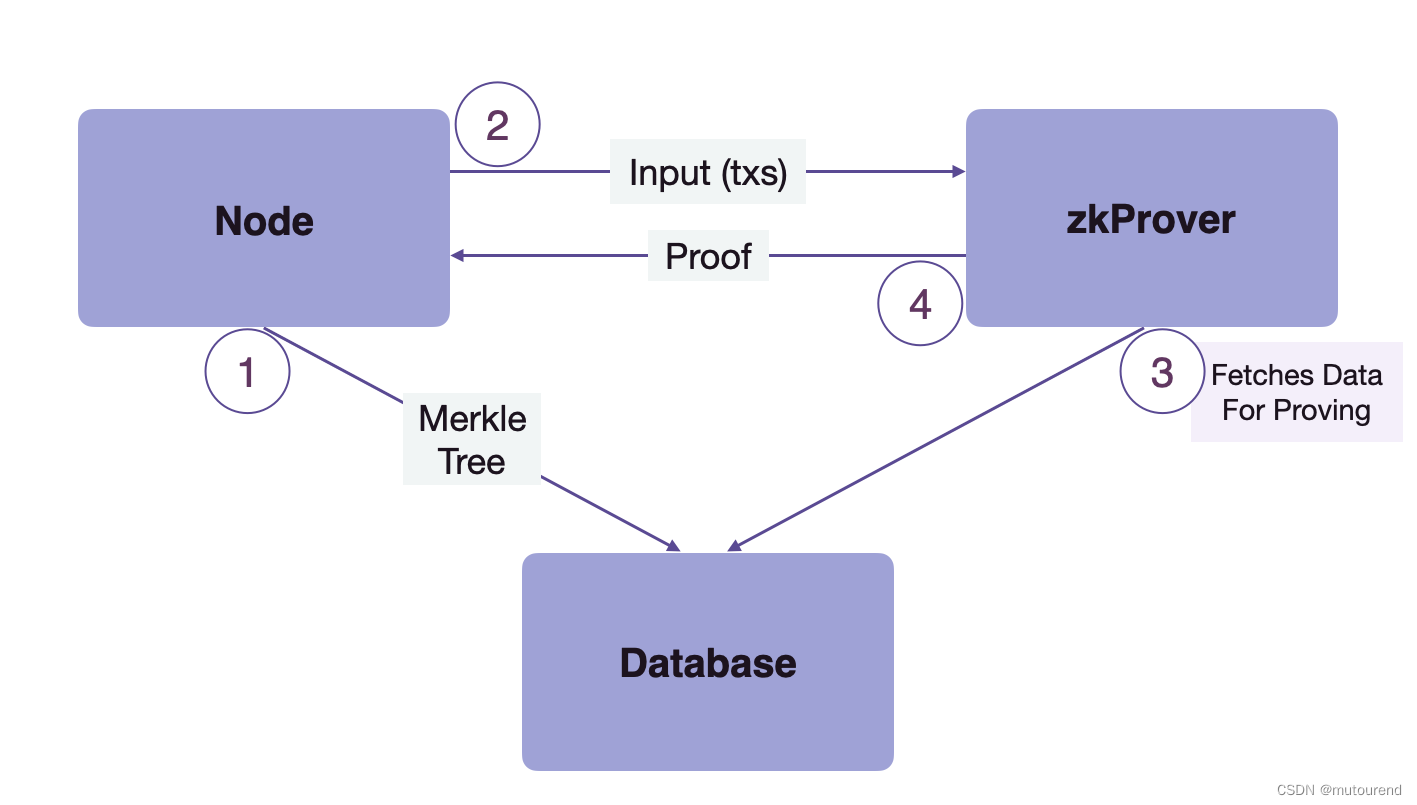
- 1)节点将Ethereum state content和EVM Merkle trees发送到DB并存储。
- 2)节点将input batch of transactions发送到zkProver。
- 3)zkProver访问DB,获取 为节点发送的transaction batch 生成verifiable proof 所需的信息。
- 4)zkProver为交易生成证明,将proof发回给节点。
3.1 zkProver中的状态机
根据zkEVM Audit Education Sessions 1/4 -Circuit Arithmetization for ZKP有:


zkProver采用模块化设计,主要由14种state machines组成:
- 1)1个Main State Machine
- 2)6个Secondary State Machine:Binary SM、Storage SM、Memory SM、Arithmetic SM、Keccak Function SM、Poseidon SM。
- 3)7个Auxiliary State Machine:Padding-PG SM、Padding-KK SM、Nine2One SM、Memory Align SM、Norm Gate SM、Byte4 SM、ROM SM。
zkProver这种模块化的设计,使得Main SM可将其职责委托给尽可能专业的state machine,通过委托实现效率的提升。
3.1.1 Secondary State Machine
Main SM Executor直接向secondary state machine发送名为Actions的合适指令 来传达命令。
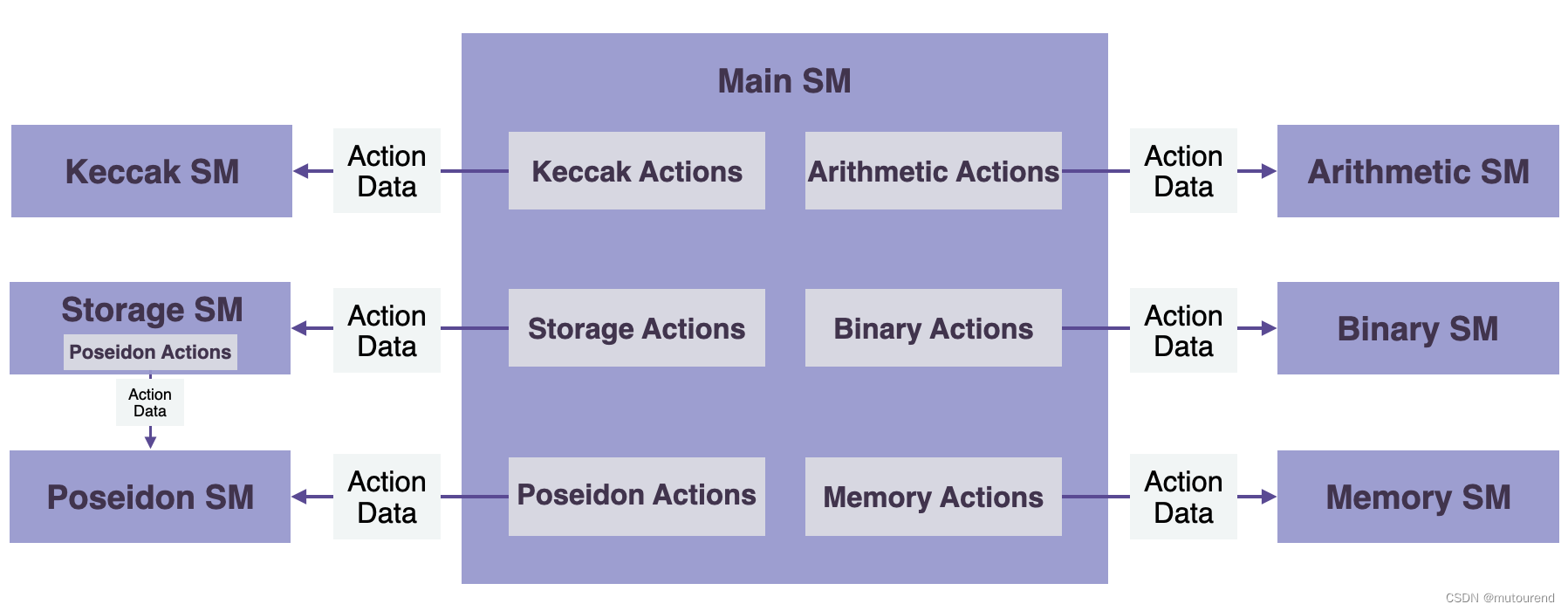
上图灰色方框即表示的是Actions。这些指令会命令 某state machine内的state如何transition。无论是来自Main SM还是来自特定SM的“Action”,每个Action都必须附加一个proof以证明其执行的正确性。
SM之间有一些相互依赖:
- 1)Storage SM会使用Merkle Trees和Poseidon SM,因其需要计算Storage Merkle Tree中所有节点的哈希值。
- 2)Keccak SM和Poseidon SM均为哈希状态机,对应的辅助状态机有Padding-KK SM和Padding-PG SM。
3.1.2 zkProver的2种编程语言
Polygon Hermez团队为zkProver创建了2种编程语言:
-
1)zkASM:Zero-Knowledge Assembly language。zkASM负责将zkProver Main SM的指令映射到其它SM。若SM有firmware,则zkASM为该firmware的解析器。
zkASM代码的输入为 来自Main SM的指令,输出为 生成特定SM Executor如何运行计算的特定assembly codes。该Executor会严格遵循zkASM代码的规则和逻辑,从而可很容易地验证计算。 -
2)PIL:Polynomial Identity Language。因为几乎所有的状态机都将计算表示为多项式。状态机内状态变化必须满足特定计算相关的polynomial identities。
Polygon zkEVM项目的主要目的是解决区块链不可能三角问题:隐私性、安全性、可扩展性,其本质是一种高效零知识承诺机制。而当前最安全和高效的承诺机制为多项式承诺机制,将计算转换成某种多项式语言是有利的,在这种语言中,验证归结为测试执行是否满足某些多项式恒等式(identities)。
zkProver状态机内的所有PIL代码,构成了verifier code的DNA。
Polynomial Identity Language(PIL)为定义state machine execution trace约束的领域特定语言。
PIL用于:- 定义execution trace多项式name
- 描述多项式identities
- 描述多项式之间关系
以满足execution是正确的。
3.1.3 Micro-Processor Context——Main SM和Storage SM
zkProver中有2种微处理器类型的状态机:
- Main SM
- Storage SM
这2种微处理器类型的状态机有:
- 1)firmware 固件部分:运行zkASM语言,以设置逻辑和规则,以JSON格式表示并存储在ROM中。特定的SM Executor将解析该JSON文件,然后根据JSON文件中的规则和逻辑执行Storage Actions。
- 2)hardware 硬件部分:运行PIL语言,以定义约束(或polynomial identities),以JSON格式表达并存储在相应的JSON文件内。与firmware类型,特定的SM Executor会解析这些约束,因为所有的计算都必须与polynomial identities一致。
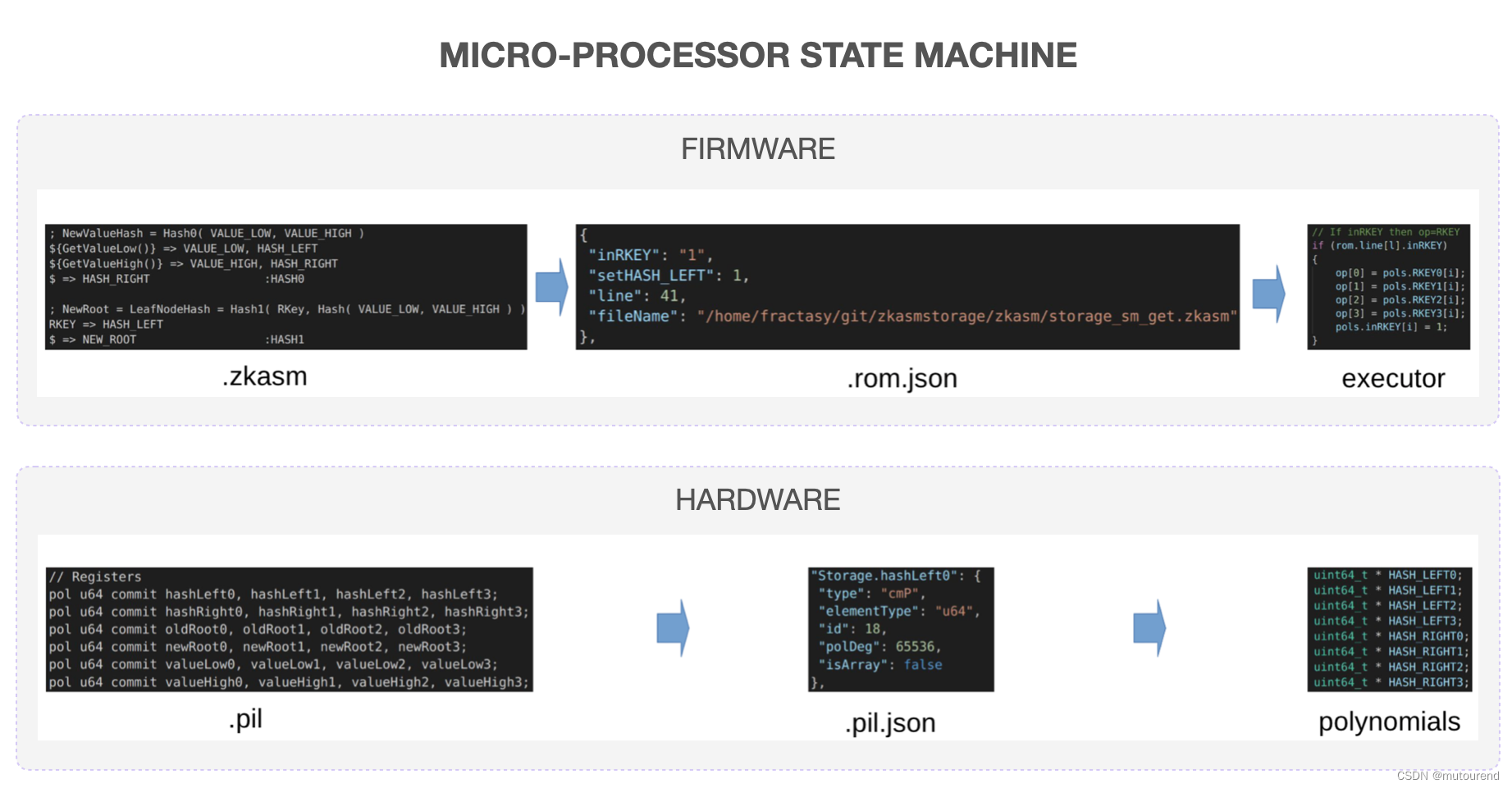
尽管Main SM和Storage SM看起来跟上图一样,但是二者区别很大:
- Storage SM擅长执行Storage Actions(又名SMT Actions),而Main SM负责更广范围的Actions。
- Main SM将大多数的Actions委托给专门的状态机,Storage SM是Secondary状态机——因其也从Main SM接收指令,但Storage SM无法给Main SM发送指令。
值得注意的是,每个微处理SM有各自的ROM。
3.1.4 zkProver中的哈希
有2个二级状态机负责哈希运算,二者均为标准密码学哈希函数的“automised”版本:
- 1)Keccak SM:为gates state machine,有一系列逻辑门(硬件)和一系列门(逻辑)之间的connections。由Keccak SM Hash Generator和Keccak PIL code组成,其中Keccak PIL code用于validation。
- 2)Poseidon SM:Poseidon哈希要比Keccak哈希算法更新,当前仍处于密码分析师的scritiny中,为zk-STARK-friendly hash function,其很适合于zkProver上下文。
若熟悉原始Poseidon哈希函数的内部机制,Poseidon SM的实现非常直观。
哈希函数的permutation过程很容易转化为Poseidon SM的状态转换。哈希函数的12个输入元素、非线性替换层(S-boxes)和线性扩散层(MDS矩阵)直接在状态机中实现。
尽管Poseidon SM是二级状态机,它同时会从Main SM和Storage SM中接收指令。
Poseidon SM有:- 2.1)executor部分
- 2.2)internal PIL code:为验证规则集,以PIL语言编写。
3.2 证明每个状态机内计算正确执行的基本方法
zkProver的状态机设计为:
- 运行程序
- 并证明“程序执行正确”
每个二级状态机内包含了:
- 1)其自身的executor
- 2)一个PIL程序:用于检查其收到的源自Main SM的指令执行正确。
系统实现交易的证明和验证的基本流程为:
- 1)将某指定计算表示为状态机SM。
- 2)将该状态机的状态变化表示为多项式。
- 3)跟踪状态变化的trace,称为execution trace,作为lookup表的行。
- 4)形成该状态变化所满足的polynomial identities/constraints。
- 5)“Prover”采用特定的多项式承诺机制来承诺和证明其知道所commit的多项式。
- 6)Plookup是一种检查Prover的committed polynomials 是否produce correct trace的方法。
多项式约束以PIL语言编写,而指令初始以zkASM语言编写,然后以JSON格式表达和存储。
尽管并不是所有的verification都包含了Plookup,但确实Plookup在zkProver中承担的了重要角色:

3.3 zkProver核心元素
zkProver主要有4大核心元素:
- 1)Executor,此处是指Main SM Executor:以交易、执行交易前的old states root、执行交易后的new states root、Sequencer的ChainID等,以及 PIL(为一组多项式、寄存器)和ROM(存储了需执行的指令集)为输入,Executor在PIL hardware层执行所有指令,并生成committed多项式——为state machine cycles 或 a list of all the states,同时还会生成某些public data——作为zk-SNARK Verifier的输入。【Main SM Executor负责将交易和相关数据转换为committed多项式】
- 2)STARK Recursion元素:输入有:committed多项式、constant多项式、scripts(指令集),输出为a zk-STARK proof。为了利用zk-STARK的快速证明,STARK Recursion中为每个zk-proof利用了FRI。之所以称为STARK Recursion,是因为:【即数百个zk-STARK proof会递归证明为一个zk-STARK proof】
- a)其确实生成了多个zk-STARK proof
- b)将这些zk-STARK proof整理捆绑为少量几个zk-STARK proof bundle
- c)为每个bundle生成了zk-STARK proof
- d)该bundle的zk-STARK proof会进一步整理并证明为一个zk-STARK proof。
- 3)CIRCOM库:输入为:STARK Recursion元素生成的单个zk-STARK proof、Verifier Data,输出为:Witness。zkProver使用CIRCOM circuit库 来生成witness for the zk-STARK proof produced by the STARK Recursion Component。【采用CIROM库,生成的witness本质就是以R1CS约束来表达的Arithmetic circuit。】
- 4)zk-SNARK Prover:为Rapid SNARK,以C++和Intel汇编语言编写,为CIRCOM输出快速生成证明。输入为:CIRCOM生成的witness、STARK verifier data(以表明Rapid SNARK如何处理该数据),输出为:a zk-SNARK proof。
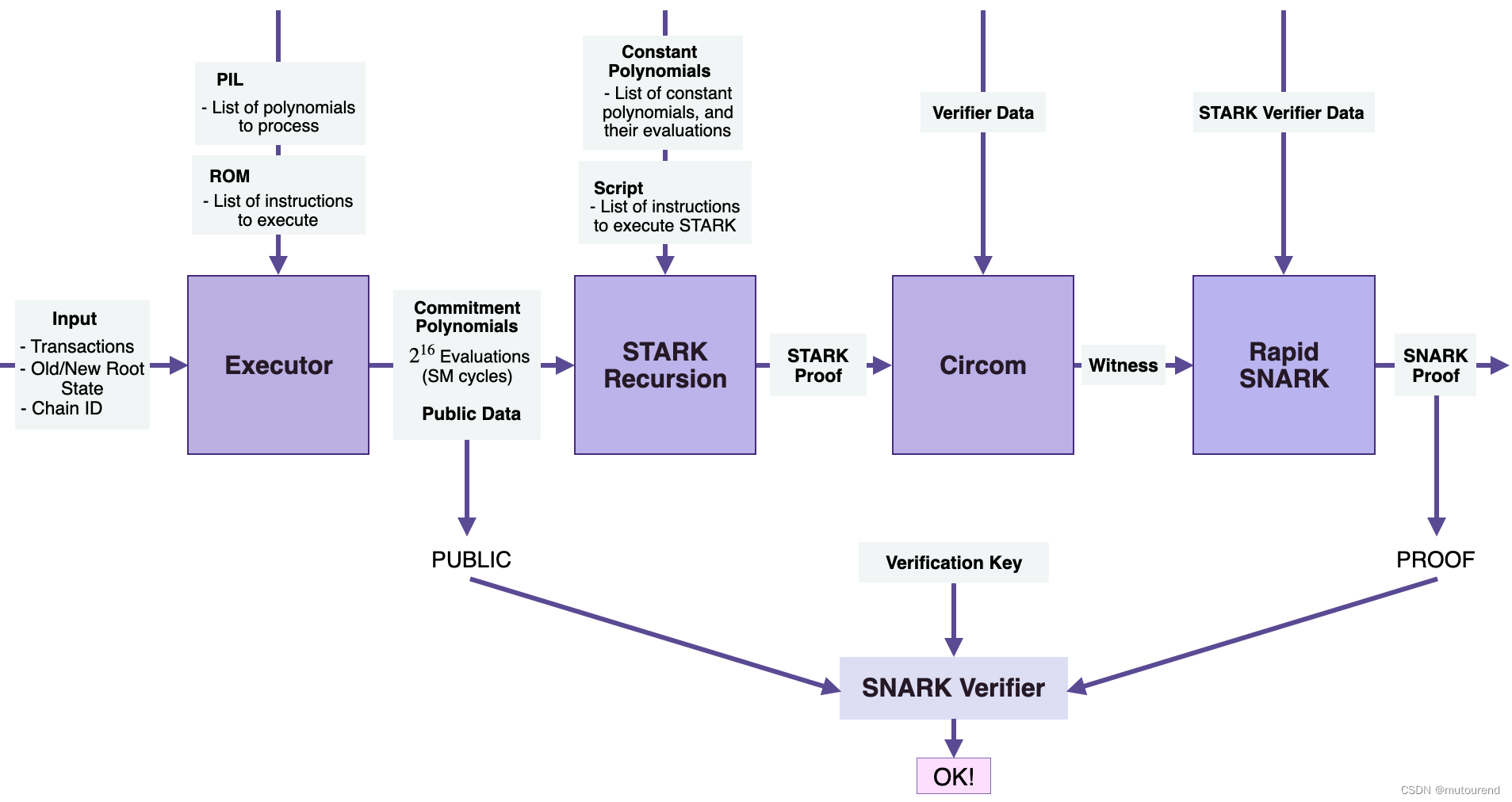
采用zk-STARK是因其证明速度很快,无需trusted setup,但是,zk-STARK的proof size很大,为此,引入zk-SNARK来证明zk-STARK proof的正确性,然后将zk-SNARK proof作为状态变化的validity proof发送到L1。借助zk-SNARK,验证validity proof的gas开销由500万降低为35万。
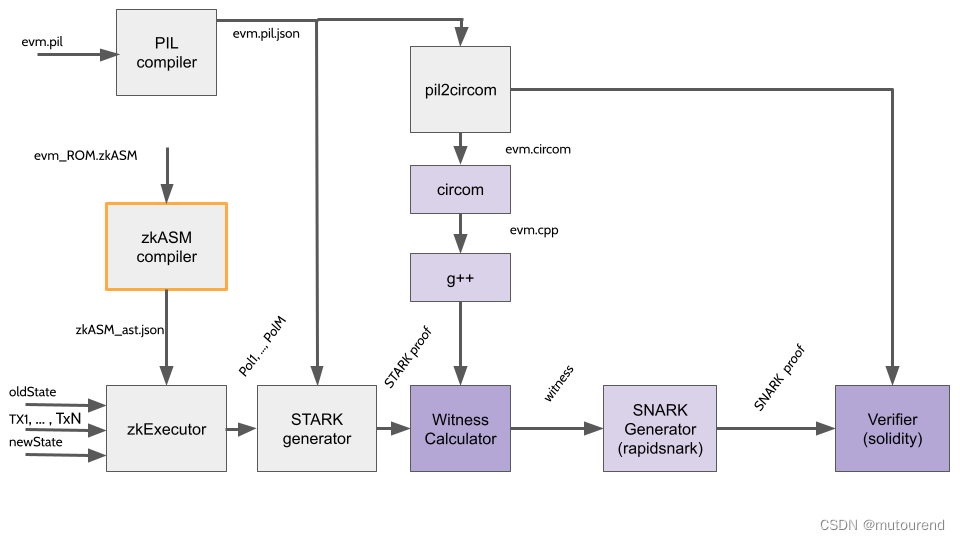
其中的rapidsnark为Iden3团队的:
4. Modular Design
对于如EVM这样的复杂state machine,其execution trace对应的列数量和identities数量可达数千。而管理如此庞大的矩阵将是非常复杂且难处理的。
为简化,Polygon zkEVM使用divide and conquer技术,将execution trace切分为更小的矩阵。
使用名为plookup的proving技术,使得一个矩阵的行 可 关联到 另一矩阵的行 成为可能。
此外,还使用了:
- inclusion:检查某矩阵的行 被包含 在另一矩阵中。
- permutation:检查某矩阵中的行 与 另一矩阵中的行 相同,只是顺序不同。
PIL语言:
- 使用
namespace关键字来命名execution trace中切分的每个矩阵的列。 - 使用
in关键字来定义inclusion。 - 使用
is关键字来定义permutation。
Polygon zkEVM中,会将execution trace切分为:
- 一个主矩阵:又名main state machine。
- 多个二级矩阵:又名secondary state machine。
借助divide and conquer技术:
- Polygon zkEVM中包含了不同的connected state machine。
- 每个state machine致力于证明某特定task的execution。
- 不同state machines之间的相关列(polynomials)使用inclusion proof(with plookup)来关联。
根据Polygon团队Jordi Baylina在2022年4月的分享Jordi Baylina - How we are building the zkEVM 可知:











5. 一个例子——Fibonacci state machine
Fibonacci序列: a 1 , a 2 , … , a n \mathbf{a_1, a_2, \dots , a_n} a1,a2,…,an,满足 a i + 1 = a i − 1 + a i \mathbf{ a_{i+1} = a_{i-1} + a_i } ai+1=ai−1+ai。
如具有12个成员的序列:
0
,
1
,
1
,
2
,
3
,
5
,
8
,
13
,
21
,
34
,
55
,
89
,
…
\mathbf{ \ \ 0,\ \ 1,\ \ 1,\ \ 2,\ \ 3,\ \ 5,\ \ 8,\ \ 13,\ \ 21,\ \ 34,\ \ 55,\ \ 89,\ \ \dots }
0, 1, 1, 2, 3, 5, 8, 13, 21, 34, 55, 89, …
很容易检查发现
377
\mathbf{377}
377和
987
\mathbf{987}
987是Fibonacci 序列成员。但若要判断
12
,
586
,
269
,
025
\mathbf{ 12,586,269,025 }
12,586,269,025是否为序列成员,则需要一个公式 或 计算机程序——本文以state machine密码学工具来实现。
5.1 Fibonacci State Machine
具有寄存器
A
=
(
A
1
,
A
2
,
…
,
A
l
)
\mathbf{A} = ( A_1, A_2, \dots , A_l )
A=(A1,A2,…,Al)和
B
=
(
B
1
,
B
2
,
…
,
B
l
)
\mathbf{B} = ( B_1, B_ 2, \dots , B_l )
B=(B1,B2,…,Bl)的状态机,第
i
i
i个状态为
(
A
i
,
B
i
)
(A_i,B_i)
(Ai,Bi),初始状态为
A
1
=
0
,
B
1
=
1
A_1=0,B_1=1
A1=0,B1=1。
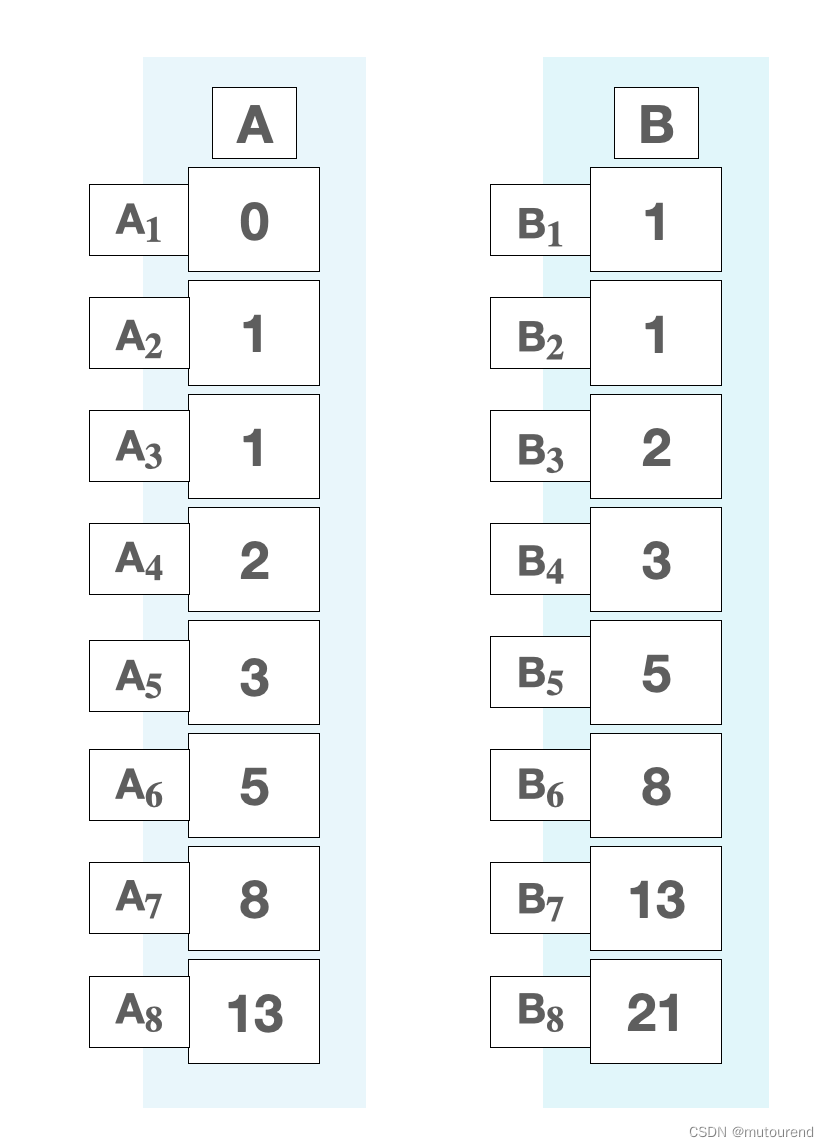
A
和
B
\mathbf{A}和\mathbf{B}
A和B寄存器均包含了Fibonacci序列,只是
B
\mathbf{B}
B中的序列为one step ahead of
A
\mathbf{A}
A,二者具有如下关系:
A
i
+
1
=
B
i
,
B
i
+
1
=
A
i
+
B
i
.
\begin{aligned} A_{i+1} &= B_i , \\ B_{i+1} &= A_i + B_i. \end{aligned}
Ai+1Bi+1=Bi,=Ai+Bi.
接下来,是将这些寄存器以多项式表示,并最终引入多项式承诺机制来构建该membership密码学工具。
5.1.1 polynomial identities
区块链传统中,将2个寄存器的多项式表示为
Z
p
[
x
]
\mathbb{Z}_p[x]
Zp[x],其系数源自a prime field
Z
p
\mathbb{Z}_p
Zp。
将多项式evaluate over subgroup of
H
=
{
ω
,
ω
2
,
ω
3
,
…
,
ω
8
=
1
}
=
⟨
ω
⟩
H = \{\omega,\omega^2,\omega^3,\dots,\omega^8 = 1\} = \langle\omega\rangle
H={ω,ω2,ω3,…,ω8=1}=⟨ω⟩ of order
8
8
8。
定义多项式
P
(
x
)
P(x)
P(x)和
Q
(
x
)
Q(x)
Q(x)为:
P
(
ω
i
)
=
A
i
,
Q
(
ω
i
)
=
B
i
.
P(\omega^i) = A_i, \\ Q(\omega^i) = B_i.
P(ωi)=Ai,Q(ωi)=Bi.
H
H
H中的每个
x
x
x形式为
x
=
ω
i
x=\omega^i
x=ωi for some
i
i
i,从而有:
P
(
x
ω
)
=
P
(
ω
i
+
1
)
=
A
i
+
1
,
Q
(
x
ω
)
=
Q
(
ω
i
+
1
)
=
B
i
+
1
.
\begin{aligned} P(x\omega) &= P(\omega^{i + 1}) = A_{i+1}, \\ Q(x\omega) &= Q(\omega^{i+1}) = B_{i+1}. \end{aligned}
P(xω)Q(xω)=P(ωi+1)=Ai+1,=Q(ωi+1)=Bi+1.
将关系
A
i
+
1
=
B
i
A_{i+1} = B_i
Ai+1=Bi and
B
i
+
1
=
A
i
+
B
i
B_{i+1} = A_i + B_i
Bi+1=Ai+Bi代入,获得如下polynomial identities:
P
(
x
ω
)
=
A
i
+
1
=
B
i
=
Q
(
ω
i
)
=
∣
H
Q
(
x
)
,
Q
(
x
ω
)
=
B
i
+
1
=
A
i
+
B
i
=
P
(
ω
i
)
+
Q
(
ω
i
)
=
∣
H
P
(
x
)
+
Q
(
x
)
.
\begin{aligned} P(x\omega) &= A_{i+1} = B_i = Q(\omega^i) = \bigg\lvert_H Q(x), \\ Q(x\omega) &= B_{i+1} = A_i + B_i = P(\omega^i) + Q(\omega^i) = \bigg\lvert_H P(x) + Q(x). \end{aligned}
P(xω)Q(xω)=Ai+1=Bi=Q(ωi)=∣∣∣∣HQ(x),=Bi+1=Ai+Bi=P(ωi)+Q(ωi)=∣∣∣∣HP(x)+Q(x).
即:
P
(
x
ω
)
=
∣
H
Q
(
x
)
,
Q
(
x
ω
)
=
∣
H
P
(
x
)
+
Q
(
x
)
.
\begin{aligned} P(x\omega) &= \bigg\lvert_H Q(x), \\ Q(x\omega) &= \bigg\lvert_H P(x) + Q(x). \end{aligned}
P(xω)Q(xω)=∣∣∣∣HQ(x),=∣∣∣∣HP(x)+Q(x).
5.1.2 Non-cyclic Polynomial Identities Problem
若以上这些polynomial identities可准确表达2个寄存器,则Fibonacci序列中的每个成员均可满足该identities。
注意, H H H的定义并未限定 i ≤ 8 i\leq 8 i≤8,若设置 i = 27 i=27 i=27,则 ω 27 \omega^{27} ω27 is in H H H,因为 ω 27 = w 8 ⋅ ω 8 ⋅ ω 8 ⋅ ω 3 = 1 ⋅ 1 ⋅ 1 ⋅ ω 3 = ω 3 \omega^{27}=w^8 \cdot \omega^8 \cdot \omega^8 \cdot \omega^3 = 1 \cdot 1 \cdot 1 \cdot \omega^3 = \omega^3 ω27=w8⋅ω8⋅ω8⋅ω3=1⋅1⋅1⋅ω3=ω3。
但是不限定 i i i值,以上polynomial identities会有问题。如令 x = ω 8 x=\omega^8 x=ω8,有:
- 对于第一个identity有:
P ( x ω ) = P ( ω 8 ⋅ ω ) = P ( ω 1 ) = A 1 = 0 , but Q ( x ) = Q ( w 8 ) = B 8 = 21 ≠ 0. \begin{aligned} &P(x \omega) = P(\omega^8 \cdot \omega) = P(\omega^1) = A_1 = 0,\ \ \text{but} \\ &Q(x) = Q(w^8) = B_8 = 21 \not= 0. \end{aligned} P(xω)=P(ω8⋅ω)=P(ω1)=A1=0, butQ(x)=Q(w8)=B8=21=0. - 对于第二个identity有:
Q ( x ω ) = Q ( ω ) = B 1 = 1 P ( x ) = P ( ω 8 ) + Q ( ω 8 ) = 21 + 13 = 34 ≠ 1. \begin{aligned} &Q(x \omega) = Q(\omega) = B_1 = 1 \\ &P(x) = P(\omega^8) + Q(\omega^8) = 21 + 13 = 34 \not= 1. \end{aligned} Q(xω)=Q(ω)=B1=1P(x)=P(ω8)+Q(ω8)=21+13=34=1.
这意味着,尽管 H H H是cyclic的,但是identities并不是cyclic的,polynomial identities 与 Fibonacci state machine寄存器 并不匹配。
为此,需要引入纠错多项式 R ( x ) R(x) R(x),使得polynomial identities也是cyclic的。纠错多项式也必须in Z p [ x ] \mathbb{Z}_p[x] Zp[x]。
5.1.3 Correcting Errors in Polynomial Identities
为Fibonacci state machine引入第三个寄存器
C
=
(
C
1
,
C
2
,
…
,
C
l
)
\mathbf{C} = ( C_1, C_2, \dots , C_l)
C=(C1,C2,…,Cl),设置该寄存器的值为
C
=
(
1
,
0
,
0
,
…
,
0
)
\mathbf{C} = ( 1, 0, 0, \dots , 0)
C=(1,0,0,…,0)。
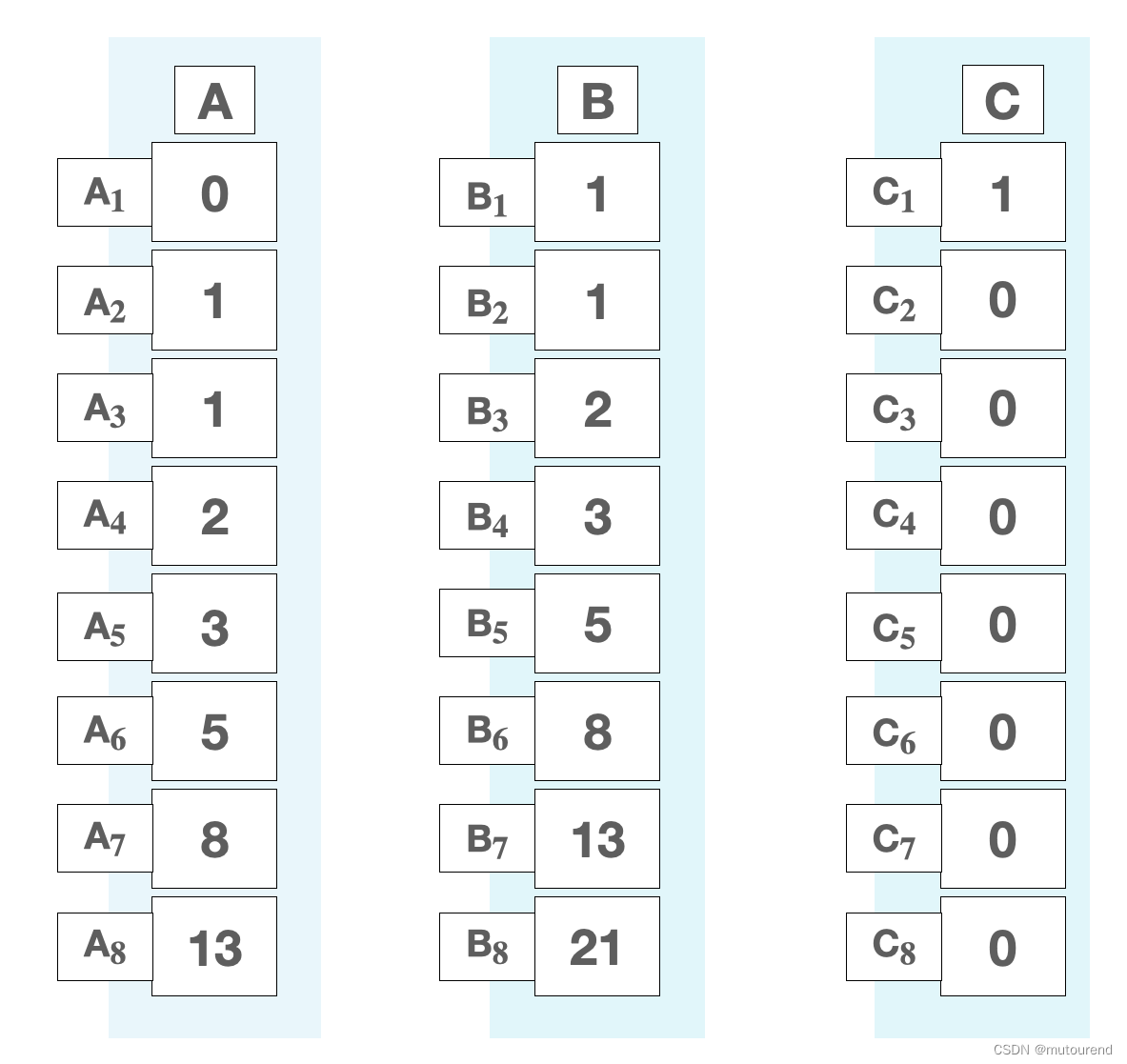
将纠错多项式
R
(
x
)
R(x)
R(x)定义为:
R
(
ω
i
)
=
C
i
.
R(\omega^i) = C_i.
R(ωi)=Ci.
即:
R
(
ω
i
)
=
C
i
=
1
,
if
i
m
o
d
8
=
1
,
R
(
ω
i
)
=
C
i
=
0
,
otherwise
.
\begin{aligned} R(\omega^i) &= C_i = 1, \text{ if }\ \ i \mod 8 = 1 , \\ R(\omega^i) &= C_i = 0, \text{ otherwise}. \end{aligned}
R(ωi)R(ωi)=Ci=1, if imod8=1,=Ci=0, otherwise.
将纠错多项式
R
(
x
)
R(x)
R(x)嵌入到之前的polynomial identities,有:
P
(
x
ω
)
=
∣
H
Q
(
x
)
(
1
−
R
(
x
ω
)
)
,
Q
(
x
ω
)
=
∣
H
(
P
(
x
)
+
Q
(
x
)
)
(
1
−
R
(
x
ω
)
)
+
R
(
x
ω
)
\begin{aligned} P(x \omega) &= \bigg\lvert_H Q(x) \big( 1 - R(x \omega) \big), \\ Q(x \omega) &= \bigg\lvert_H \big( P(x) + Q(x) \big) \big( 1 - R(x \omega) \big) + R(x \omega) \end{aligned}
P(xω)Q(xω)=∣∣∣∣HQ(x)(1−R(xω)),=∣∣∣∣H(P(x)+Q(x))(1−R(xω))+R(xω)
接下来,仍然设置 x = ω 8 x=\omega^8 x=ω8,来检查新的polynomial identities是否是cyclic的:
- 对于第一个identity有:
L H S = P ( x ω ) = P ( ω 8 ⋅ ω ) = P ( ω 1 ) = A 1 = 0 , R H S = Q ( x ) ( 1 − R ( x ω ) ) = Q ( ω 8 ) ( 1 − R ( ω 8 ⋅ ω ) ) = A 8 ( 1 − R ( ω ) ) = 13 ( 1 − 1 ) = 0. \begin{aligned} LHS &= P(x \omega) = P(\omega^8 \cdot \omega) = P(\omega^1) = A_1 = 0, \\ RHS &= Q(x) \big( 1 - R(x \omega) \big) = Q(\omega^8) \big( 1 - R(\omega^8 \cdot \omega) \big) = A_8 \big( 1 - R(\omega) \big) = 13 \big( 1 - 1 \big) = 0. \end{aligned} LHSRHS=P(xω)=P(ω8⋅ω)=P(ω1)=A1=0,=Q(x)(1−R(xω))=Q(ω8)(1−R(ω8⋅ω))=A8(1−R(ω))=13(1−1)=0.
因此当 x = ω 8 x=\omega^8 x=ω8时,第一个identity成立。很容易检查当 x x x为 H H H中的其它值时,也成立。 - 对于第二个identity有:
L H S = Q ( x ω ) = Q ( ω 8 ⋅ ω ) = Q ( ω 1 ) = B 1 = 1 , R H S = ( P ( ω 8 ) + Q ( ω 8 ) ) ( 1 − R ( ω 8 ⋅ ω ) ) + R ( ω 8 ⋅ ω ) = ( A 8 + B 8 ) ( 1 − R ( ω 1 ) ) + R ( ω 1 ) = ( 13 + 21 ) ( 1 − 1 ) + 1 = 1. \begin{aligned} LHS &= Q(x \omega) = Q(\omega^8 \cdot \omega) = Q(\omega^1) = B_1 = 1 ,\\ RHS &= \big( P(\omega^8) + Q(\omega^8) \big) \big( 1 - R(\omega^8 \cdot \omega) \big) + R(\omega^8 \cdot \omega) \\ &= \big( A_8 + B_8 \big) \big( 1 - R(\omega^1) \big) + R(\omega^1)\\ &= \big( 13 + 21 \big) \big( 1 - 1 \big) + 1 = 1 . \end{aligned} LHSRHS=Q(xω)=Q(ω8⋅ω)=Q(ω1)=B1=1,=(P(ω8)+Q(ω8))(1−R(ω8⋅ω))+R(ω8⋅ω)=(A8+B8)(1−R(ω1))+R(ω1)=(13+21)(1−1)+1=1.
因此当 x = ω 8 x=\omega^8 x=ω8时,第二个identity成立。很容易检查当 x x x为 H H H中的其它值时,也成立。
5.1.4 Varied Initial Conditions
注意,此处不再限定初始条件为
(
A
1
,
B
1
)
=
(
0
,
1
)
\big( A_1 , B_1 \big) = \big( 0 , 1 \big)
(A1,B1)=(0,1)。
将polynomial identities调整为适于任意初始条件
(
A
1
,
B
1
)
\big( A_1 , B_1 \big)
(A1,B1):
P
(
x
ω
)
=
∣
H
Q
(
x
)
(
1
−
R
(
x
ω
)
)
+
A
1
R
(
x
ω
)
,
Q
(
x
ω
)
=
∣
H
(
P
(
x
)
+
Q
(
x
)
)
(
1
−
R
(
x
ω
)
)
+
B
1
R
(
x
ω
)
.
\begin{aligned} P(x \omega) &= \bigg\lvert_H Q(x) \big( 1 - R(x \omega) \big) + A_1 R(x \omega), \\ Q(x \omega) &= \bigg\lvert_H \big( P(x) + Q(x) \big) \big( 1 - R(x \omega) \big) + B_1 R(x \omega) . \end{aligned}
P(xω)Q(xω)=∣∣∣∣HQ(x)(1−R(xω))+A1R(xω),=∣∣∣∣H(P(x)+Q(x))(1−R(xω))+B1R(xω).
5.1.5 Proving Our State Machine(High level)

之前的多项式关系可通过如 KZG 和 基于FRI 的多项式承诺来证明。
承诺机制具有binding和hiding属性:
- 1)Binding:一旦commit之后,Prover无法修改多项式。
- 2)Hiding:仅知道承诺值,Verifier无法推导出Prover所commit的具体多项式。
6. 一个例子——Arithmetic State Machine
arithmetic state machine将检查32bit元素的加减乘除运算。
约束中有5个寄存器:
A
i
⋅
B
i
+
C
i
=
2
32
D
i
+
E
i
.
\mathcal{A}_i \cdot \mathcal{B}_i + \mathcal{C}_i = 2^{32} \mathcal{D}_i + \mathcal{E}_i.
Ai⋅Bi+Ci=232Di+Ei.
注意,以上五个寄存器均为32bit的。
跟之前类似,将该关系表示为a cyclic polynomial identity at some subgroup
H
H
H of roots of unity of
Z
p
\mathbb{Z}_p
Zp:
A
(
x
)
⋅
B
(
x
)
+
C
(
x
)
=
2
32
D
(
x
)
+
E
(
x
)
.
\mathcal{A}(x) \cdot \mathcal{B}(x) + \mathcal{C}(x) = 2^{32} \mathcal{D}(x) + \mathcal{E}(x).
A(x)⋅B(x)+C(x)=232D(x)+E(x).
注意,此处需要 enforce A ( x ) \mathcal{A}(x) A(x), B ( x ) \mathcal{B}(x) B(x), C ( x ) \mathcal{C}(x) C(x), D ( x ) \mathcal{D}(x) D(x) 和 E ( x ) \mathcal{E}(x) E(x) 在 H H H 的值均为32bit。






















 824
824











 被折叠的 条评论
为什么被折叠?
被折叠的 条评论
为什么被折叠?








